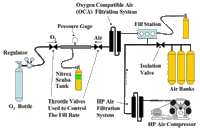So after pouring over the Oxyhackers book and tons of print-outs and articles from this and other forums (you guys are a wealth of knowledge ), I finally decided to go with the following (and rationale therefor):
), I finally decided to go with the following (and rationale therefor):
- partial pressure blending system (while I like the nitrox stick notion, I want the flexibility of blending He in the future for trimix - sounds very tricky already, let alone with the stick). I don't mind the extra O2 process and cleaning procedures.
- Bauer Oceanus (have ONLY heard/read great things about Bauer. Junior model not rated for continuous operation/filling banks).
- 3 bottle bank/cascade system (2 LP and 1 HP).
- LF hyperfilter for OCA (I know it's debatable but don't want to mess around)
- maybe a Haskel booster (when I start mixing Trimix to save He) - otherwise not worth the $$ now to leave only 500-ish PSI of O2.
I plan to mix about 10-20 tanks worth of Nitrox and about the same for air each month.
Now, I'm kind of stuck trying to figure out the detail and lost in a forest of information. The book is great but unless I read it too fast, it doesn't really layout details in terms of "you need to put this here....". In other words, what regulators, valves, throttle valves, check valves, whips, hoses, fittings, gauges, tubes, analyzers, etc. I have a rough layout of the system (see pic - yes, ripped off from "nitroxmadeeasy.com") but now need to get down and dirty in the details and start buying hardware! I downloaded the GMC catalog and that is an entire other forest of forests.
Does anyone out there have a detailed schematic or list that they would like to share?
Maybe some general advice could help like:
-Does each bank have to have it's own gauge and/or valve?
-Where do I have to put in check valves (to prevent back flow?)
-Where do I have to put regulators (O2 and where else?)
Maybe I'm "over-engineering" this in my mind?
Thanks
- partial pressure blending system (while I like the nitrox stick notion, I want the flexibility of blending He in the future for trimix - sounds very tricky already, let alone with the stick). I don't mind the extra O2 process and cleaning procedures.
- Bauer Oceanus (have ONLY heard/read great things about Bauer. Junior model not rated for continuous operation/filling banks).
- 3 bottle bank/cascade system (2 LP and 1 HP).
- LF hyperfilter for OCA (I know it's debatable but don't want to mess around)
- maybe a Haskel booster (when I start mixing Trimix to save He) - otherwise not worth the $$ now to leave only 500-ish PSI of O2.
I plan to mix about 10-20 tanks worth of Nitrox and about the same for air each month.
Now, I'm kind of stuck trying to figure out the detail and lost in a forest of information. The book is great but unless I read it too fast, it doesn't really layout details in terms of "you need to put this here....". In other words, what regulators, valves, throttle valves, check valves, whips, hoses, fittings, gauges, tubes, analyzers, etc. I have a rough layout of the system (see pic - yes, ripped off from "nitroxmadeeasy.com") but now need to get down and dirty in the details and start buying hardware! I downloaded the GMC catalog and that is an entire other forest of forests.
Does anyone out there have a detailed schematic or list that they would like to share?
Maybe some general advice could help like:
-Does each bank have to have it's own gauge and/or valve?
-Where do I have to put in check valves (to prevent back flow?)
-Where do I have to put regulators (O2 and where else?)
Maybe I'm "over-engineering" this in my mind?
Thanks





